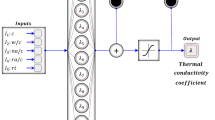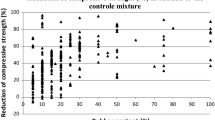Abstract
In recent years, car tires are considered one of the most crucial environmental pollution problems in many countries. Therefore, reusing waste rubber crumbs from recycled tires as aggregates for concrete has attracted increasing attention. Rubberized concrete could also be an economical and environmentally-friendly construction material. Besides, enhancing the ductility, toughness, thermal insulation, and impact resistance are also advantageous while using rubberized concrete. On the contrary, rubberized concrete’s mechanical properties are highly dependent on the replacement amount of rubber. Thus, the estimation of the compressive strength of rubberized concrete is crucial for engineering applications. In this study, 162 experimental results collected from the literature are used to construct a database and attempt to predict the compressive strength of rubberized concrete. An artificial neural network (ANN) is developed, using 7 input variables, namely binder, superplasticizer, water, fine aggregate, coarse aggregate, crumb rubber, and chipped rubber. The model performance is evaluated using three performance indicators, such as root mean square error (RMSE), mean absolute error (MAE), the Pearson correlation coefficient (R). The results show that the proposed ANN algorithm exhibits excellent prediction performance and accurately estimated the compressive strength of rubberized concrete. The results in the present research are useful and could provide a reference for engineers in predicting the compressive strength of rubberized concrete.
Access this chapter
Tax calculation will be finalised at checkout
Purchases are for personal use only
Similar content being viewed by others
References
Almaleeh, A.M., Shitote, S.M., Nyomboi, T.: Use of waste rubber tyres as aggregate in concrete. 8, 11–19 (2017).
Eldin NN, S.A.: Rubber tire particles as concrete aggregate. J Mater Civil Eng ASCE 5(4):478–496. (1993)
Toutanji, H.A.: The use of rubber tire particles in concrete to replace mineral aggregates. Cement and Concrete Composites. 18, 135–139 (1996).
Khatip ZK, B.F.: Rubberized Portland cement concrete. J Mater Civil Eng ASCE 11(3):206–213. (1999)
Ling, T.-C.: Prediction of density and compressive strength for rubberized concrete blocks. Construction and Building Materials. 25, 4303–4306 (2011).
Sun, Y., Li, G., Zhang, J., Qian, D.: Prediction of the Strength of Rubberized Concrete by an Evolved Random Forest Model. Advances in Civil Engineering. 2019, 1–7 (2019).
Elkhoja, A., Ashour, A., Abdalhmid, J., Khan, A.: Prediction-of-Rubberised-Concrete-Strength-by-Using-Artificial-Neural-Networks-. (2018)
Hadzima-Nyarko, M., Nyarko, K., Ademovic, N., Miličević, I., Kalman Šipoš, T.: Modelling the Influence of Waste Rubber on Compressive Strength of Concrete by Artificial Neural Networks. Materials. 12, 561 (2019).
Gesoğlu, M., Güneyisi, E., Ozturan, T., Özbay, E.: Modeling the mechanical properties of rubberized concretes by neural network and genetic programming. Materials and Structures. 43, 31–45 (2010).
Dao, D.V., Nguyen, N.-L., Ly, H.-B., Pham, B.T., Le, T.-T.: Cost-Effective Approaches Based on Machine Learning to Predict Dynamic Modulus of Warm Mix Asphalt with High Reclaimed Asphalt Pavement. Materials. 13, 3272 (2020).
Le, T.-H., Nguyen, H.-L., Pham, B.T., Nguyen, M.H., Pham, C.-T., Nguyen, N.-L., Le, T.-T., Ly, H.-B.: Artificial Intelligence-Based Model for the Prediction of Dynamic Modulus of Stone Mastic Asphalt. Applied Sciences. 10, 5242 (2020).
Ly, H.-B., Le, T.-T., Vu, H.-L.T., Tran, V.Q., Le, L.M., Pham, B.T.: Computational Hybrid Machine Learning Based Prediction of Shear Capacity for Steel Fiber Reinforced Concrete Beams. Sustainability. 12, 2709 (2020).
Nguyen, M.D., Pham, B.T., Ho, L.S., Ly, H.-B., Le, T.-T., Qi, C., Le, V.M., Le, L.M., Prakash, I., Son, L.H., Bui, D.T.: Soft-computing techniques for prediction of soils consolidation coefficient. CATENA. 195, 104802 (2020).
Author information
Authors and Affiliations
Corresponding author
Editor information
Editors and Affiliations
Rights and permissions
Copyright information
© 2022 The Author(s), under exclusive license to Springer Nature Singapore Pte Ltd.
About this paper
Cite this paper
Ly, HB. (2022). Prediction of the Compressive Strength of Rubberized Concrete Based on Machine Learning Algorithm. In: Ha-Minh, C., Tang, A.M., Bui, T.Q., Vu, X.H., Huynh, D.V.K. (eds) CIGOS 2021, Emerging Technologies and Applications for Green Infrastructure. Lecture Notes in Civil Engineering, vol 203. Springer, Singapore. https://doi.org/10.1007/978-981-16-7160-9_193
Download citation
DOI: https://doi.org/10.1007/978-981-16-7160-9_193
Published:
Publisher Name: Springer, Singapore
Print ISBN: 978-981-16-7159-3
Online ISBN: 978-981-16-7160-9
eBook Packages: EngineeringEngineering (R0)




